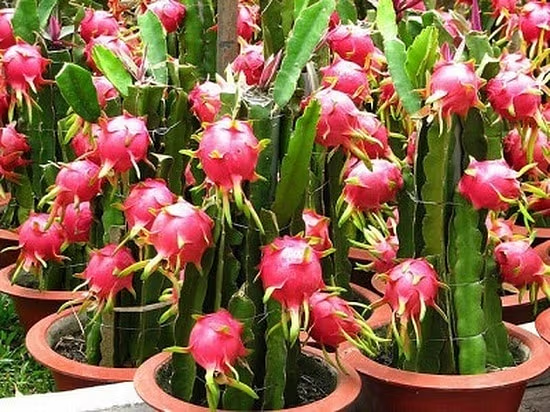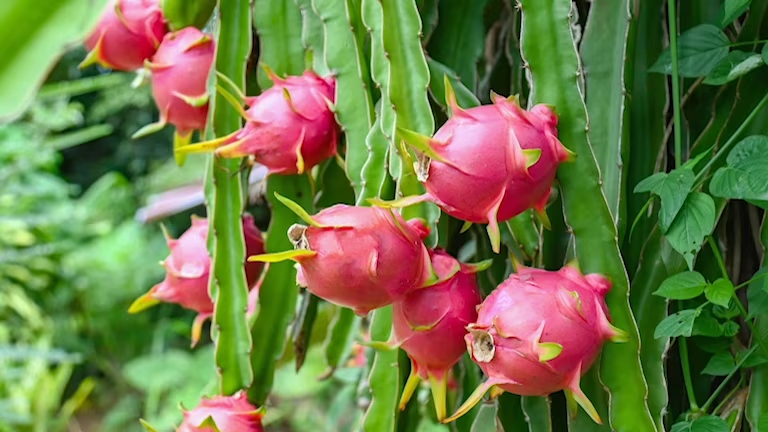If you’ve ever admired the striking pink or yellow-skinned fruits of the dragon fruit cactus and wished you could grow your own, you’re in luck. Dragon fruit (Hylocereus spp.), with its vibrant appearance and mildly sweet, nutrient-rich flesh, is surprisingly well-suited for indoor gardening — provided you give it the right care and conditions.
This detailed, beginner-friendly guide will walk you through everything you need to know about successfully growing dragon fruit indoors — from choosing the right variety and planting method to providing optimal light, water, and support.
Whether you’re working with a sunny apartment, greenhouse window, or heated sunroom, you can enjoy this tropical treasure at home. Let’s get started!
What is Dragon Fruit?

Dragon fruit, also known as pitaya or strawberry pear, is a climbing cactus native to Central and South America. Belonging to the Hylocereus genus, it produces large, fragrant, night-blooming flowers and distinctive oval-shaped fruits with bright skin and tiny black seeds embedded in a white, red, or purple pulp.
Though typically grown outdoors in tropical and subtropical climates, with the right care, dragon fruit thrives indoors as a container plant.
Why Grow Dragon Fruit Indoors?
Growing dragon fruit indoors offers several advantages:
- Adds a unique, tropical plant to your home decor.
- Produces highly nutritious fruit rich in antioxidants, vitamin C, fiber, and minerals.
- Easy to grow in containers and relatively low-maintenance.
- Great for regions with cold winters or limited outdoor space.
- Its exotic flowers and trailing cactus branches make a stunning indoor feature.
Best Dragon Fruit Varieties for Indoor Growing

There are several varieties of dragon fruit, but for indoor cultivation, opt for compact, hardy, and preferably self-pollinating types:
- Hylocereus undatus
- Pink skin with white flesh
- Fast-growing and adaptable indoors
- Hylocereus costaricensis
- Pink skin with red flesh
- Very decorative, slightly slower-growing
- Hylocereus megalanthus
- Yellow skin with white flesh
- Sweetest fruit, but more delicate
Pro tip: For indoor growers, choosing a self-pollinating variety is ideal since it can produce fruit without cross-pollination from other plants.
Step-by-Step Guide to Growing Dragon Fruit Indoors
1. Choose the Right Container
Dragon fruit is a climbing cactus with a shallow but widespread root system, so it needs a wide, deep pot to anchor its trellis and accommodate its roots.
Container requirements:
- Minimum 10–15 gallons for mature plants.
- Drainage holes to prevent waterlogging.
- Heavy-bottomed or weighted pots for stability, as dragon fruit becomes top-heavy.
2. Use Well-Draining Soil
Like most cacti, dragon fruit needs loose, well-draining soil to thrive.
Ideal soil mix:
- 40% cactus mix
- 30% organic compost
- 20% coarse sand or perlite
- 10% pumice or fine gravel
Tip: Avoid using heavy garden soil as it retains too much moisture, risking root rot.
3. Install a Support Structure
Indoors, dragon fruit will need a sturdy trellis, stake, or support system to climb.
Without proper support, the plant can become unruly and prone to breakage.
Options:
- Wooden stake
- PVC pipe frame
- Wire tomato cage
- Decorative trellis attached to the pot
As the cactus grows, gently tie or train the stems upward for a neat, healthy structure.
4. Provide Adequate Light
Light is the most important factor when growing dragon fruit indoors. It requires 6–8 hours of direct or bright, indirect sunlight daily.
Best light sources:
- South-facing windows
- Sunrooms or glassed patios
- Supplemental grow lights (LED or fluorescent)
If natural light is limited, position an LED grow light 6–12 inches above the plant and leave it on for 10–12 hours a day to mimic sunlight.
5. Water Carefully
Though dragon fruit likes moisture during its growing season, it hates wet feet. Overwatering is the primary cause of failure indoors.
Watering tips:
- Water thoroughly when the top 1–2 inches of soil feels dry.
- Allow excess water to drain.
- Reduce watering frequency during the winter when growth slows.
- Avoid misting directly on the stems to prevent fungal issues.
6. Maintain Ideal Temperature & Humidity

Dragon fruit thrives in warm, humid conditions.
Optimal indoor temperatures:
- Day: 65–85°F (18–29°C)
- Night: Not below 50°F (10°C)
If indoor air is dry, especially during winter, increase humidity with:
- A humidity tray filled with water and pebbles.
- Regular misting near the plant.
- A small room humidifier.
7. Fertilize Regularly
Feed your dragon fruit cactus with a balanced, slow-release fertilizer during its active growing season (spring to early fall).
Recommended fertilizers:
- Balanced NPK 10-10-10 or 20-20-20
- Organic options: liquid seaweed, fish emulsion, or compost tea
Fertilizing schedule:
- Once a month in spring and summer
- Every 6–8 weeks in fall
- Skip feeding in winter
Propagating Dragon Fruit Indoors

While you can grow dragon fruit from seeds, it’s much faster and reliable to start from cuttings.
Propagation from cuttings:
- Cut a healthy stem segment (12–15 inches long).
- Let the cut end dry for 2–3 days until calloused.
- Plant in prepared soil about 2–3 inches deep.
- Water lightly and place in a sunny spot.
Roots typically develop in 2–4 weeks.
Flowering and Fruit Development Indoors
Dragon fruit plants usually flower in summer, producing large, beautiful, night-blooming flowers. Indoor plants might take 1–2 years from cuttings before flowering.
Pollination Tips:
- If your variety is self-pollinating, fruit can set naturally.
- For cross-pollination varieties, hand-pollinate using a soft brush to transfer pollen from flower to flower.
- Flowers bloom for one night — be ready to pollinate when it opens!
Fruit Ripening:
Fruits take 30–50 days from pollination to mature. They’re ready when the skin turns bright pink or yellow and the scales start to wither slightly.
Common Indoor Growing Challenges

- Overwatering: Causes root rot and fungal diseases.
- Low light: Leads to leggy, weak growth and no flowers.
- Nutrient deficiency: Results in pale, stunted plants.
- Pest issues: Mealybugs and spider mites may appear indoors.
Solution:
Use natural insecticidal soap or neem oil, adjust watering, and provide sufficient light.
Indoor Dragon Fruit Care Calendar
| Season | Care Tasks |
|---|---|
| Spring | Repot if needed, resume regular watering, fertilize monthly |
| Summer | Maintain sunlight, water often, hand-pollinate flowers |
| Fall | Reduce watering, light feeding |
| Winter | Minimal watering, no fertilizer, provide bright light |
Final Thoughts
Growing dragon fruit indoors may seem unconventional, but with the right setup, it’s both practical and rewarding. This resilient climbing cactus, with its stunning night-blooming flowers and antioxidant-rich fruits, makes a unique addition to any home garden.
Focus on good light, well-draining soil, careful watering, and sturdy support, and you’ll soon enjoy the sight of your very own homegrown dragon fruit cactus thriving indoors.



